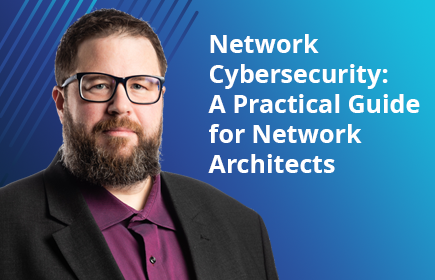
Securing enterprise networks has never been more challenging or critical. With businesses migrating to cloud-based solutions, workforces embracing hybrid work styles, and cybersecurity threats increasing in number and methods, network architects must rethink how they design and secure vital business networks. Mike Frane, Chief Product Officer at Nitel, offers valuable insights into network security trends, as well as practical advice for network professionals who may be struggling to navigate this complex landscape.
The New Landscape of Network Security
Frane sees a seismic shift in how businesses approach their networks: “There’s a trend today: our customers are shifting from an MPLS network to SD-WAN or SASE networks. Our customers’ networks are subjected to increasing sprawl through rapidly growing work locations – including employees working in hybrid environments.”
Network sprawl places more demand on network security. Traditional models that relied on Ethernet-based or MPLS networks no longer suffice. Mike explains, “It’s time to move away from solely Ethernet-based networks to hybrid networks that integrate best-effort services like cellular, satellite, and broadband.”
Embracing Integrated Solutions
The convergence of network and security teams has also transformed how organizations manage their networks. Frane says, “it used to be that we had one distinct conversation about networking with the networking group, and a separate, distinct conversation with the security teams about the security elements. We now have a unified discussion with both groups as we design and deploy networks. And we’re continuing to see a collapse of the networking groups and the security groups.”
Network and security management integration is critical for building cohesive, secure systems. Network architects must ensure their designs address both operational and security needs simultaneously. Unified discussions between networking and security teams will go a long way toward eliminating gaps, reducing inefficiencies, and creating resilient systems that adapt to evolving threats.
Avoiding Common Mistakes in Network Security
Frane highlights key pitfalls that network architects often encounter when designing secure, modern networks. The first is resisting new technologies. “We’ve seen so many times that network engineers and networking groups want to move to SD-WAN because they’re moving apps to the cloud, and they want to make SD-WAN work just like their MPLS network did,” he says. “But doing that risks losing the SD-WAN advantages in resiliency, redundancy, and survivability.”
Instead of retrofitting new technologies into legacy approaches, architects should focus on unlocking the full value of SD-WAN and SASE. This includes understanding on-ramps to the cloud. Frane emphasizes the importance of designing bandwidth and access strategies early so those solutions aren’t driven by a last-minute rush to get everyone into the cloud.
Practical Security Strategies for the Cloud Era
Security challenges grow as businesses rely more on cloud applications and hybrid work models. Frane stresses the importance of integrating security solutions with centralized policy management. “Centralizing policies can create a much more comprehensive and cohesive security environment for your locations and remote users,” he explains.
Traffic classification and egress management are also critical to network security. “If you’re a retailer who offers customer Wi-Fi or shopper Wi-Fi, that type of traffic doesn’t need to go through a large cloud firewall as a service and an IDP engine,” said Frane. “You could drop that off natively or locally to the internet rather than sending it back to your cloud scrubbers or your SSE security service edge platform for security analysis.”
Nitel’s Approach to Cybersecurity
At Nitel, Frane’s team prioritizes customer success by aligning technical and operational strategies. “We need to ensure the alignment of our customer’s technical and operational teams to make sure that they have the support they need to get the most out of their networks in terms of performance and security,” he says.
This alignment is supported by a range of services tailored to each customer:
- FasTrack Process: Nitel offers a highly automated and digital delivery system for small deployments that accelerates project timelines.
- Managed Service Center: “This group is dedicated to SD-WAN, SASE, and our firewall services,” Frane says. “Unlike most service providers and MSPs, this team will not do a lot of basic troubleshooting. This team understands that you have a more complicated network, and you likely have more skills as an end user. So we don’t go through the ‘blinky lights’ of power evaluation.”
The Nitel Managed Service Center team provides cradle-to-grave support, handling everything from final design to deployment and day-two operations. “There’s no throwing anything over a fence. There’s no finger-pointing,” Frane emphasizes. “Our managed service center handles the final design, the deployment, and the day-two operations of the network.”
Why Network Architects Choose Nitel
Frane highlights four key reasons why network architects partner with Nitel:
- Network Support that’s Truly Expert: The Managed Service Center delivers comprehensive lifecycle support for complex networks.
- Broad Portfolio: Nitel offers solutions from SD-WAN and SASE to Ethernet, broadband, and satellite services, ensuring flexibility to meet all customer needs.
- Single Point of Contact: Nitel integrates access aggregation to seamlessly manage underlay and overlay services.
- MyNitel Portal: A robust tool for visibility and control over installations, trouble tickets, billing, and managed services.
Building Resilient, Secure Networks
As businesses migrate to the cloud and adopt distributed, hybrid work models, network architects face increasing pressure to design secure, scalable, and high-performing systems. Architects can meet these challenges head-on by embracing modern technologies, avoiding legacy pitfalls, and leveraging Nitel’s expertise.
Frane notes that the key to success lies in collaboration, innovation, and adaptability: “At Nitel, we’re here to guide you through this process and ensure your networks deliver the reliability, security, and performance your business demands.”

